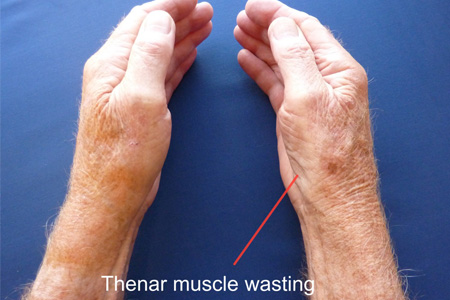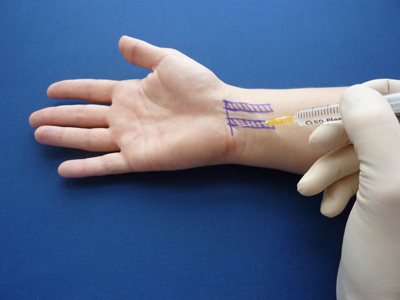Carpal Tunnel Injection
When to inject
As a treatment where significant symptoms and there is an identifiable cause such as pregnancy.
For symptom control prior to surgery.
As a diagnostic test in cases of uncertainty.
When to avoid injection
- If there is wasting of the thenar muscles
- If permanent sensory loss
- These cases need surgery to prevent progression of the neuropathy
- Local or systemic infection

Risks and complications
Skin depigmentation, dermal atrophy, adipose atrophy, particularly if injection too superficial
Flare of symptoms
Increased blood sugars in diabetic patients, this may last for 3-7 days with significant elevation of blood sugars
Facial flushing particularly in ladies
Equipment
Antiseptic spray spray ( alcoholic chlorhexidine) , dressings/ plaster for after injection, gloves.
5ml of 1 or 2 % lidocaine, 5 ml syringe, drawing up needle.
Long orange needle 25mm, 25 gauge
20-40 mg of triamcinolone or Kenalog in a separate 1ml syringe
Where to inject
After antiseptic application and under strict ascetic technique. Just on the ulnar side of the palmaris longus tendon at or just distal to the distal wrist crease. The palmaris longus tendon is medial to the flexor carpi radialis and is best located by opposing the thumb and fifth digit while the wrist is flexed. Angle the needle at approximately 40 degrees to the skin, aim for the middle of the base of the ring finger. Insert needle very slowly and avoid the median nerve
Inject local anaesthetic first then change the syringe and inject steroid and with draw the needle. This should be done with the fingers flexed. The fluid should flow freely, if not you may be in a tendon.
Pearls
Some people do not have a palmaris longus (PL) tendon. In these cases, the needle is inserted at the midline between the radial and ulnar aspects of the wrist, proximal to the wrist crease, and is directed toward the ring finger.
An alternative and possible safer and more accurate injection technique involves inserting the needle 1cm proximal to the wrist crease and directed distally by roughly 45 degrees in an ulnar direction through the flexor carpi radialis tendon.
The use of a needle smaller in diameter may require increased effort and slower injection time but dramatically reduces pain at the site of injection.
Sudden worsening of pain or paraesthesia indicates the possibility of improper needle placement. If this occurs, retract the needle and redirect more medially (ulnar). Advancing the needle very slowly will minimise the risk of intraneural injection.
To avoid potential complications of vascular or nerve ischemia, tissue necrosis, and serious damage to nerve, lidocaine with adrenaline should not be used

